The red hue symbolises a sense of passion, heat, love, activity, sexuality, or joy. People love to bring these senses by adding red flowers. Red flowers with red stems can stand out from others and can leave anyone in awe.
Here, I will provide you with a list of plants that have red blooms on red stalks. You can identify them by their images. To make it easy for you, I will tell you about their appearance too. You can scroll through images and create your favourite list to add to your living space.
In addition, I will tell you about growing conditions and the secrets to nurturing these striking botanical wonders. If you are ready, let’s get on with it.
➡ Hear this article:
You can hear the Audio version of this article, too.
Bergenia: Bell-like red flowers with red stems
Scientific name: Bergenia cordifolia ‘Red Beauty
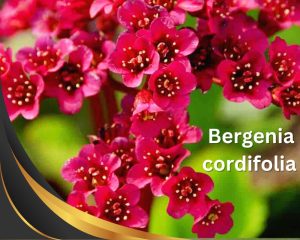
Bergenia, also known as Pigsqueek ‘Rotblum”, is a remarkable flowering plant. Its red stems elegantly uphold clusters of lush green leaves, providing the perfect backdrop for the vivid pink to red flowers. Its flowering is in the late winter or early spring with charming bell-like blooms. Hence, Bergenia, by a burst of colour, goes to greet spring. With its fleshy, heart-shaped leaves, it can bring beauty to nature even in the coldest months.
Caring Requirements for Bergenia:
Sunlight: Bergenia thrives in partial to full shade conditions. It prefers indirect sunlight to prevent leaf scorching.
Soil: Well-draining soil rich in organic matter is ideal. Bergenia can tolerate slightly acidic to neutral pH levels.
Watering: Keep the soil consistently moist but not waterlogged. Water deeply when the top inch of soil feels dry.
Fertilisation: Apply a balanced, slow-release fertiliser in spring and midsummer to promote healthy growth.
Pruning: Trim dead or yellowing leaves close to the base to maintain the plant’s appearance.
Winter Care: Mulch around the base to protect the plant’s roots from freezing temperatures.
Bleeding Heart: hear-shaped red flowers with red stems
Scientific name: Dicentra Spectabilis
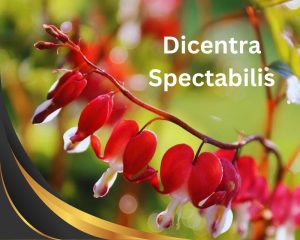
The Bleeding Heart, scientifically known as Dicentra spectabilis, is another entrancing member of the red-stemmed family. Its arching branches bear uniquely heart-shaped flowers, each dangling like delicate pendulums. These flowers exhibit a stunning gradient from deep crimson at the base to a lighter shade towards the tip, creating an ethereal ombre effect. With its fern-like foliage and gracefully drooping blossoms, the Bleeding Heart is a favourite among gardeners seeking to add an air of enchantment to their landscapes.
Caring Requirements for Bleeding Heart:
Sunlight: Partial to full shade is optimal for Bleeding Heart. Too much sun can scorch its delicate foliage.
Soil: Well-draining, rich, and loamy soil is preferred. Adequate moisture is essential for its growth.
Watering: Keep the soil consistently moist, especially during dry periods.
Fertilisation: Apply a balanced, slow-release fertiliser in early spring and after flowering.
Mulching: Apply a layer of mulch to retain moisture and suppress weed growth.
Division: Divide the plant every few years to rejuvenate its growth and maintain its vigour.
Columbine: five-petaled red flowers on the red stems
Scientific name: Aquilegia sp.

Aquilegia, commonly referred to as Columbine, is a diverse genus that includes varieties with red stems and blossoms. The colour of stems may turn green or red. The unique flower structure of Columbine consists of five distinct, spurred petals that give the plant an almost fairy-like appearance. The red-stemmed varieties display a remarkable contrast between their green foliage and the fiery red hues of their flowers. These adaptable plants thrive in various climates and are often celebrated for attracting pollinators like hummingbirds.
Caring Requirements for Columbine:
Sunlight: Columbine thrives in partial shade but can tolerate full sun in cooler climates.
Soil: Well-draining, moist soil with good organic content is recommended.
Watering: Keep the soil consistently moist but not waterlogged. Mulching helps retain moisture.
Fertilisation: Apply a balanced, slow-release fertiliser in early spring and after flowering.
Deadheading: Remove spent flowers to encourage prolonged blooming and prevent self-seeding.
Division: Divide the plant every few years to maintain its vigour and prevent overcrowding.
Hellebore Annas Red: saucer-shaped crimson blooms with red stems
Scientific name: Helleborus x iburgensis ‘Anna’s Red’
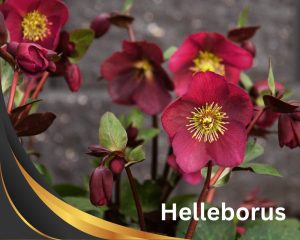
Hellebores, or Helleborus, are known for their exquisite, drooping flowers that often bloom in the colder months. The red-stemmed Hellebores are no exception, as their deep-coloured stems elegantly complement the nodding, cup-shaped flowers. These plants are highly prized for their ability to flourish in shade and provide a much-needed splash of colour during the winter when many other plants lay dormant.
Caring Requirements for Hellebore:
Sunlight: Part to full shade is ideal for Hellebores. Avoid harsh afternoon sun.
Soil: Well-draining, humus-rich soil with good moisture retention is crucial.
Watering: Water consistently to keep the soil evenly moist, especially during flowering.
Mulching: Apply a layer of mulch to maintain soil moisture and protect the roots from extreme temperatures.
Division: Divide clumps every few years to prevent overcrowding and promote vigorous growth.
Deer Resistance: Hellebores are often deer-resistant, making them a great choice for gardens prone to browsing wildlife.
Mask Flower: stunning tubular red flowers with red stems
Scientific name: Alonso asp.
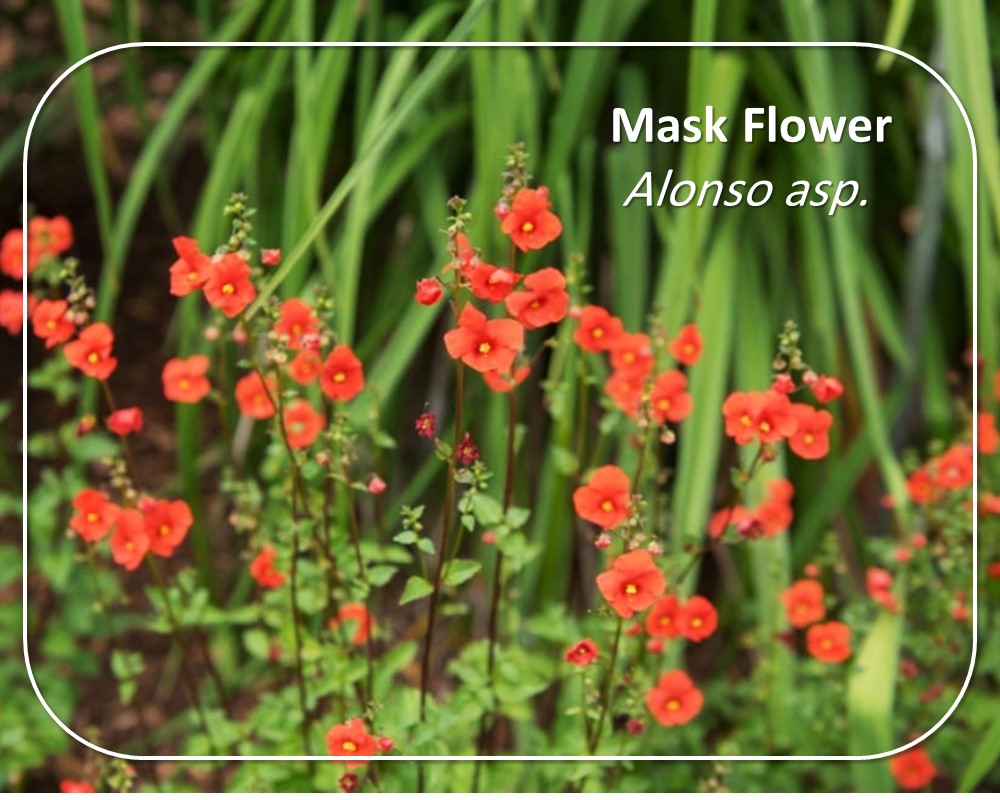
Alonsoa, commonly referred to as Mask Flower, is a small yet captivating plant with red stems and vibrant red blossoms. The flowers are tubular and bear a resemblance to a masquerade mask, hence the name. This plant’s compact size and profuse blooming make it an ideal choice for borders, containers, or hanging baskets, adding a touch of whimsy to any garden setting.
Caring Requirements for Mask Flower:
Sunlight: Mask Flower thrives in full sun to light shade. It prefers at least six hours of direct sunlight.
Soil: Well-draining, slightly acidic to neutral soil is recommended.
Watering: Water regularly to keep the soil consistently moist but not waterlogged.
Fertilisation: Apply a balanced liquid fertiliser every two to three weeks during the growing season.
Deadheading: Remove faded flowers to encourage continuous blooming.
Pest Control: Monitor for pests like aphids and caterpillars and address them promptly.
American Pokeweed: small red flowers on elongated clusters and red stems
Scientific name: Phytolacca Americana
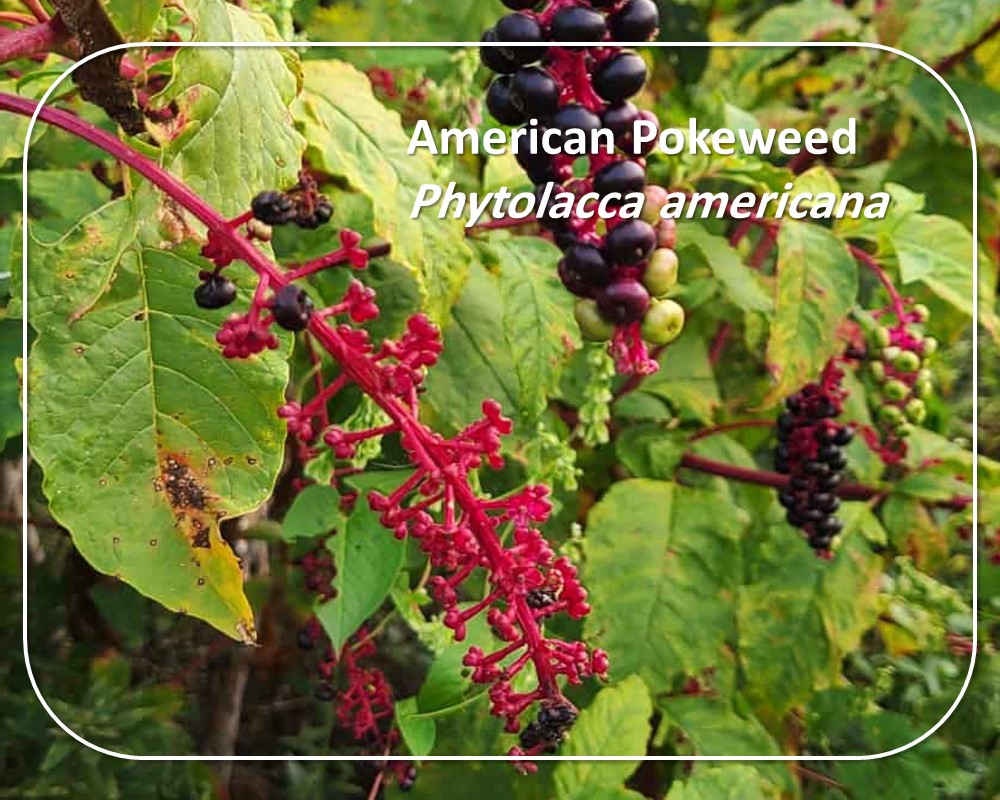
The American Pokeweed, scientifically known as Phytolacca americana, is a plant that commands attention with its striking appearance. Its tall, vibrant red stems give rise to clusters of berries that transform from a vivid green to a deep, alluring shade of purple-black. This transformation is like a natural work of art that unfolds before our eyes, captivating both our senses and our curiosity.
Caring Requirements for American Pokeweed:
Sunlight: This plant thrives in full sun to light shade. Hence, it can be a good choice to adapt to various garden settings.
Soil: A well-draining and fertile soil with the nutrients it needs to flourish.
Watering: A regular watering is essential, particularly during its growing
Pro tip: As it matures, American Pokeweed may require support to prevent its tall stems from bending under the weight of its berries.
Bromeliad: red tropical flowers on a red stem
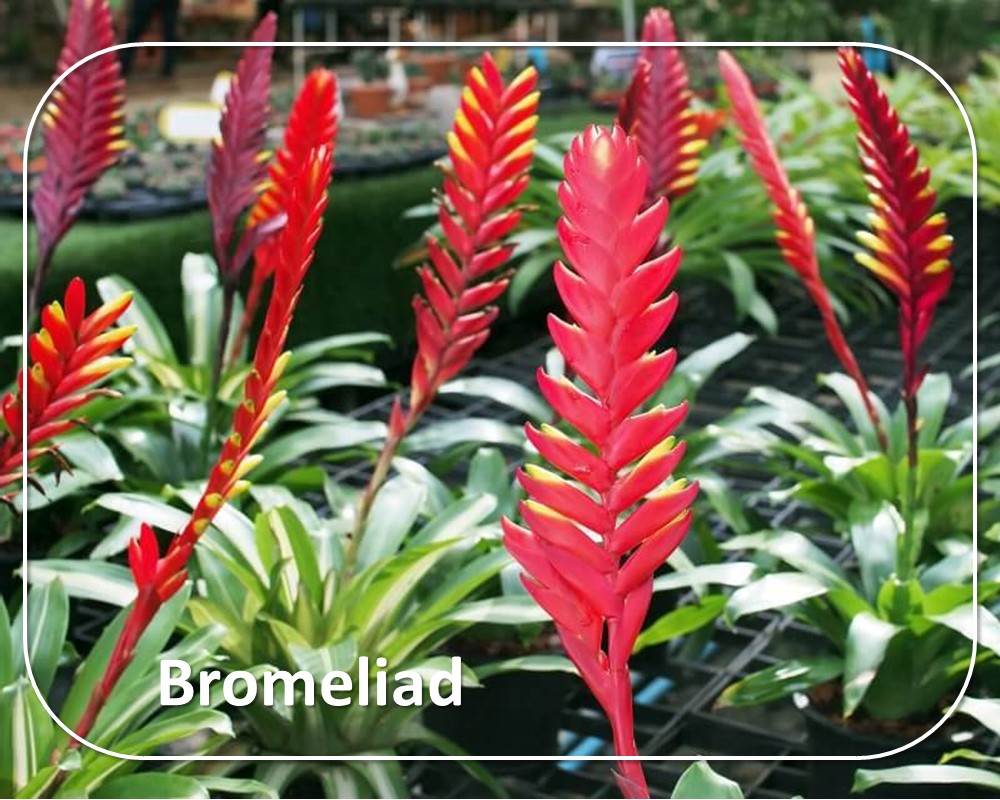
Bromeliads are a kind of succulent with red stems. They are known for their unique and captivating appearance, and when they feature red flowers with red stems, their allure is truly irresistible. These tropical wonders are often associated with warm, lush environments, making them a cherished addition to gardens around the world.
Caring Requirements for Bromeliad:
Creating the perfect environment for Bromeliads to thrive involves mimicking their native tropical habitats. They require bright, indirect light to showcase their vibrant colours, and well-draining soil is essential to prevent root rot. Unlike many plants, Bromeliads do not rely solely on their roots for water absorption—instead, they gather moisture through their central cups. This unique feature makes them particularly fascinating to observe. To care for a Bromeliad, water should be poured directly into its central cup, ensuring that it remains filled.
Bronze Leaf Begonia: red orchid-like flowers with red stems
Scientific name: Begonia Semperflorens

The Bronze Leaf Begonia, scientifically known as Begonia semperflorens, is a true testament to the elegance that a red stem can bring to a plant. Its stunning foliage and delicate blooms create an atmosphere of refinement that is a joy to behold. This plant is mid to highly toxic to pets.
Caring Requirements for Bronze Leaf Begonia:
Begonias are cherished for their ability to thrive in shaded areas where other plants might struggle. The Bronze Leaf Begonia is no exception. It prefers filtered light and well-draining soil that retains moisture without becoming waterlogged. Regular watering is necessary to keep the soil consistently moist, and a balanced fertiliser can help promote healthy growth and blooming.
Sundial Red Portulaca: A Colourful Groundcover with red flowers and stems
Scientific name: Portulaca grandiflora ‘Sundial Red’
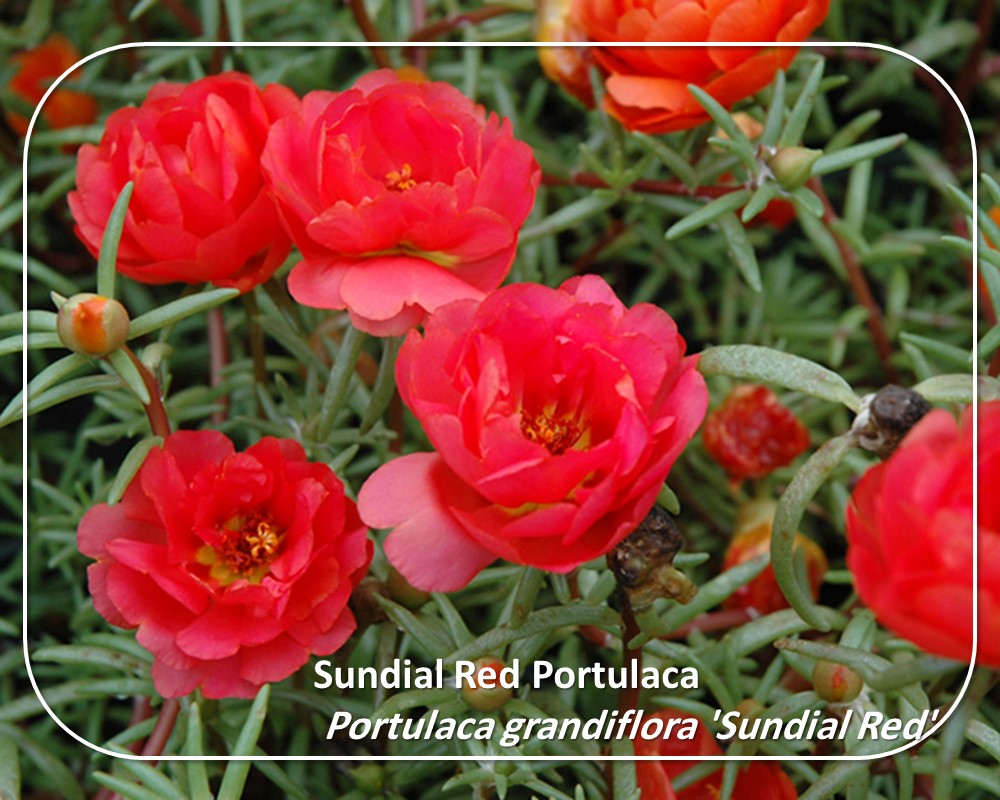
Sundial Red Portulaca, scientifically known as Portulaca grandiflora ‘Sundial Red’, boasts red stems that add a delightful contrast to its vibrant blooms. This low-growing succulent is often used as a groundcover and can turn empty spaces into a tapestry of colour.
Caring Requirements for Sundial Red Portulaca:
Sundial Red Portulaca is a hardy succulent with the ability to tolerate drought. Hence, it is a suitable choice for gardens with low rainfall. You should provide a full sun place for it. This plant needs well-draining soil. You must allow the soil to dry out between waterings. Its vibrant flowers attract pollinators, enhancing the beauty of any garden landscape.
Conclusion
Now, you have a list of red flowers with red stems, with their images, and scientific and common names. In addition, you found out a lot of pro tips for growing these stunning flowers. Which of the plants in the above list are your favourite plants? Why? Can you add a new flowering plant with red blooms and stems to our list?
In the following, you can see some of the most frequent questions about red flowers with red stems. Some of them can be your question too, so keep reading.
Frequently Asked Questions about ref flowers with red stems
Q: Can I grow American Pokeweed in containers?
A: While American Pokeweed can grow in containers, it’s important to choose a large container to accommodate its height and spread. Be mindful of its vigorous growth and provide appropriate support.
Q: Are Bromeliads suitable for indoor cultivation?
A: Yes, Bromeliads can thrive indoors, provided they receive sufficient bright, indirect light and proper care. Make sure to water them by filling their central cups and misting their leaves occasionally.
Q: How often should I water a Bronze Leaf Begonia?
A: Bronze Leaf Begonias prefer consistently moist soil, so water them whenever the top inch of the soil feels dry. Be cautious not to overwater, as their roots can rot in waterlogged conditions.
Q: Can I eat the flowers of Common Purslane?
A: Yes, you can! The flowers of Common Purslane are not only edible but also have a mild, tangy flavour. They can be a colourful addition to salads, providing both visual appeal and a refreshing taste.
Q: Do these plants require any special care during winter?
A: Each plant has its winter care requirements. American Pokeweed may benefit from mulching to protect its roots from freezing temperatures. Bromeliads should be brought indoors if temperatures drop too low. Bronze Leaf Begonias and Common Purslane may need protection from frost, so consider covering them or moving them indoors during cold spells.
Q: Can I propagate these plants to create more of them?
A: Yes, you can propagate these plants through various methods. American Pokeweed can be propagated from seeds or by dividing established plants. Bromeliads can be propagated by removing offsets or pups that grow at the base of the plant. Bronze Leaf Begonias can be propagated from stem cuttings, and Common Purslane can be grown from seeds or stem cuttings.
Q: Are these plants attractive to wildlife or pests?
A: American Pokeweed’s berries are often enjoyed by birds, but the plant itself can be toxic to pets and humans if ingested. Bromeliads can attract insects like aphids, but they are generally not high-risk plants for pests. Bronze Leaf Begonias can be susceptible to aphids, mealybugs, and spider mites. Common Purslane’s flowers attract pollinators, and its succulent leaves can deter some pests.
Q: Can I grow these plants in containers or hanging baskets?
A: Yes, all of these plants can be grown in containers or hanging baskets. However, consider the size and growth habits of each plant. American Pokeweed requires a large container due to its height. Bromeliads are well-suited for containers and can add a touch of the tropics to your space. Bronze Leaf Begonias and Common Purslane are excellent choices for containers and hanging baskets, allowing you to showcase their vibrant colours up close.
Q: How often should I fertilise these plants?
A: Fertilisation needs vary among these plants. American Pokeweed benefits from a balanced fertiliser applied in spring. Bromeliads require a diluted liquid fertiliser applied to their central cups every few months. Bronze Leaf Begonias benefit from a balanced fertiliser every four to six weeks during the growing season. Common Purslane doesn’t require heavy fertilisation and can thrive in soil with moderate fertility.
Q: Can I create a mixed planting using these plants?
A: Absolutely! Mixing these plants in your garden can create a diverse and visually appealing landscape. However, consider their individual needs—like sunlight requirements and growth habits—when planning your arrangement. Combining their unique colours and forms can result in a vibrant and dynamic garden space that draws attention and admiration.

Elahe Rabiei
Hi, I’m Elaheh. My Academic major is plant protection, and houseplants are my expertise. As a houseplant lover, my house is full of indoor plants and it is my passion to take care of them. Hence, I’m here to share my knowledge and experience about growing healthy houseplants. I am also a plant protection advisor, so feel free to ask me any questions you may have.

